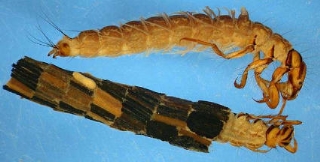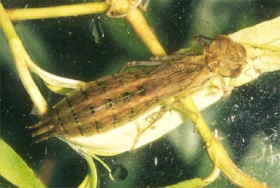|
Blackstone River Watershed Association
|
|
|
BRWA NEWS
|
Volunteers work with
BRWA to Cleanup Local Waterways
Kevin and Owen Roche tackle trash at Fisherville Pond in Grafton
during the 2013 BRWA Riverways Cleanup. Photo by Susan Thomas..
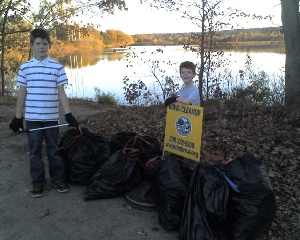
|
Once again, the quality of the Blackstone River watershed has been
improved due to the hard work and dedication of volunteers who set
aside a few hours on Sunday, October 20th to clean up trash along the
shores and in the channels of local waterways. As part of the its
7th annual Blackstone Valley Riverways Cleanup, the BRWA removed 60
large garbage bags worth of general litter as well as car and bicycle
tires, furniture, construction debris, electronics, and auto parts.
Volunteers also retrieved a paddler's dry box containing an iPhone
and two sets of keys!
Sites cleaned during Sunday's event included the Quinsigamond River
and Fisherville Pond in Grafton, the Mumford and Blackstone Rivers in
Northbridge, and the Mumford and Blackstone River, Blackstone Canal,
and Rice City Pond in Uxbridge. After the cleanup, volunteers enjoyed
refreshments generously donated by Stop and Shop of Grafton and
Hannafords of Uxbridge. Please mark your calendars for April 20, 2014
for the BRWA's annual EarthDay Cleanup. Together, we can make the
Blackstone a healthier and more enjoyable resource.
top
|
Nature Photography
Workshop is focus of Member Appreciation Event
The BRWA will hold its Member Appreciation
Event and Annual Meeting on Sunday, November 3rd beginning at 12:30
pm at River Bend Farm Visitor Center in Uxbridge, MA. Award-winning
professional nature photographer, John Slonina, will give a 90-minute
presentation on Fundamentals of Nature Photography. There will be
time for questions after the talk, followed by an hour of hands-on
shooting time for all participants along the Blackstone Canal. John
will be giving pointers about composition and technique to everyone
during the outdoor session.
John Slonina (
www.sphotography.com) is well-known
for his striking images, his knowledge and understanding
of natural history and photography, and for the very
successful photo tours and workshops he has conducted
in many different states across the country.
This lecture and workshop is intended for anyone who
would like to improve their nature photos. It will be
beneficial for photographers of any skill level, from
beginners to experts, using any kind of camera.
There will also be a brief business meeting that will include an
overview of the BRWA's past year's accomplishments and upcoming
year's goals. Members will then vote on Board of Directors and
Officers for 2014. Light refreshments will be served.
Please RSVP for this workshop to
events@thebrwa.org.
To learn more about the BRWA and how to become a member,
visit www.thebrwa.org!
top
|
BRWA Volunteers Party on the Pond
On two Sundays in August, the BRWA hosted a Pull-the-Plants Party to
remove invasive Asian water chestnut plants from Rice City Pond in
Uxbridge. Volunteers partied hard and removed nearly 150 baskets full,
which collectively contained more than 9,000 plants! A genuinely good
time was had by all and this tremendous work was accomplished in less
than eight hours.
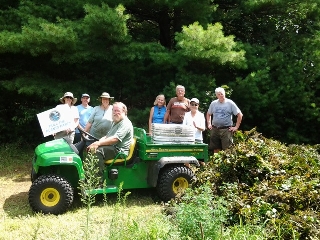
Water chestnut plants grow nuts that detach and fall to the bottom
of the pond or river, where its seeds can remain viable for as long
as 12 years! They are also easily spread by currents or birds carrying
the seeds to other areas. The plant’s rosettes form dense floating mats
that limit light and oxygen, prevent the growth of native plants, and
impede recreational activities.
This is the third year that the BRWA has focused on eradicating the
annual invasive from Rice City Pond and the water looks more beautiful
and is more ecologically balanced, thanks to the help of our volunteers
and donors.
top
|
Blackstone Water Quality
Monitors Help Shape Hopedale Permit
In August, the U.S. EPA issued the new National Pollution Discharge
Elimination System (NPDES) permit for Hopedale's waste water treatment
plant (WWTP) which empties into the Mill river. NPDES permits comply
with the Federal Clean Water Act by establishing allowable limits for
various pollutants including phosphorus. A limit of 0.160 mg/l of total
phosphorus was set for the growing season running from April 1 - October 31st.
A winter limit running November 1 - March 31 was set at 1.0 mg/l.
A time table was established for the WWTP to achieve these limits.
These low limits were set, in part, due to the efforts of the
volunteer monitors working with the Blackstone River Coalition.
Mike Sperry of the BRWA is the Field Coordinator for the monitoring
program's midreach team, which covers Grafton down to the R.I. border.
This permit will remain in effect for a five year period after which
the EPA will establish the next review process. More information
can be found at
www.epa.gov/region1/npdes/permits_listing_ma.html.
For more information on the volunteer monitoring system, go to
www.zaptheblackstone.org
or www.thebrwa.org.
top
|
|
CALENDAR OF EVENTS
|
November is National Novel Writing Month
Many writers get their inspiration from the natural
world around them. Perhaps it's because, in order to create, you must remove
yourself from all the modern-day distractions such as electronic
communication devices. Why limit yourself to a novel? Head outdoors with
pen and paper and write a letter to a far-away friend or start your
year-end reflections.
|
|
11/3
|
BRWA Member Appreciation Event 2013: Nature Photography Lecture and Workshop by John Slonina.
12:30pm. See above
for details.
|
|
11/9
|
Blackstone River Coalition Water Quality Monitoring.
|
|
11/16
|
BRWC Open House.
8:30 a.m. to 12:30 p.m. Lincoln, RI.
info.
|
|
11/16
|
MACC Fall Conference: Invasive Plant Species: Pick Your Battles to Win!
8:00am - 3:45pm. Clark University, Worcester. Contact: 617.489.3930
or staff@maccweb.org.
info.
|
|
11/17
|
Ecological Impacts of Climate Change in New England.
Sponsored by Mass Audubon and the New England Wild
Flower Society. 1:30pm - 3:30pm. Garden in the Woods, Framingham.
Contact 781-259-2200 or
drumlinfarm@massaudubon.org.
info.
|
|
11/20
|
Blackstone River Watershed Council Monthly Meeting.
6:30-8:30 p.m., Lincoln, R.I.
info
|
|
11/21
|
BRWA Board Meeting.
6:45pm 271 Oak St., Uxbridge
info
|
top
|
THINK GLOBAL, ACT LOCAL
|
Governor Proposes $911 Million Environmental Bond Bill
The Massachusetts legislature is considering
Governor Patrick's proposed environmental bond bill, H. 3332, which was
announced in September. The Trust for Public Land is backing the bill
with the economic argument that state dollars that are spent on the
conservation of our natural resources yield a greater return back to the
state's economy at a ratio of 4:1. The Secretary of the Department of
Energy and Environmental Affairs is backing the bill by promoting the
connection between our quality of life and clean drinking water. Clean
water, essential for both human consumption as well as a healthy aquatic
ecosystem, can only be attained through watershed-level protection. This
includes conservation of wetlands and other lands that buffer and filter
out pollutants such as excess phosphorus and nitrogen. It also requires
implementation and enforcement of stringent water permits that regulate
land use practices at the municipal and regional level. Legislative
consideration of the proposed bill is the responsibility of the Joint
Committee on Environment, Natural Resources and Agriculture, which is
charged with reviewing issues concerning the state's land and water
resources. Details of the proposed bill can be found at
www.mass.gov/legis/journal/desktop/2013/H3332.pdf.
top
|
Proposed Expansion of the Bottle Bill
 The State Legislature is also considering a
proposal to expand the state's current bottle bill to include bottled
water, sport drinks, ice tea, and fruit juices. Anyone that participates
in the BRWA's river cleanups (Next One: Sunday April 20, 2014!) can attest
to the fact that these non-deposit bottles are trashing our waterways and
shorelines. Increasing the amount of recycling would directly benefit the
Blackstone River and it's watershed.
The State Legislature is also considering a
proposal to expand the state's current bottle bill to include bottled
water, sport drinks, ice tea, and fruit juices. Anyone that participates
in the BRWA's river cleanups (Next One: Sunday April 20, 2014!) can attest
to the fact that these non-deposit bottles are trashing our waterways and
shorelines. Increasing the amount of recycling would directly benefit the
Blackstone River and it's watershed.
top
|
Fall Fishing
For those who experience the Blackstone watershed
through fishing, now is the time to try your luck with rainbow trout.
The Massachusetts Division of Fish and Wildlife has stocked this species
in a number of waterbodies within our region. These include: Wallum Lake
in Douglas, Lake Quinsigamond in Shrewsbury, Lake Singletary in Sutton,
and Webster Lake in Webster. Happy fishing!
On a related note, the State wants to remind boaters that all paddlers
must use personal flotation devices (PFDs) on the water through May 15th.
top
|
Proposed Changes to Water Quality Standards
The U.S. EPA is accepting public comments through
December 3, 2013 on its proposed changes to the nation's water quality
standards. These standards are a major component of the Clean Water Act,
which was originally enacted in 1972. The EPA's goal with these changes
is to clarify some of the regulatory areas in order to "lead to improved
water quality standard development, implementation and compliance as well
as improving the ability of water systems to adapt and respond to the
impacts of climate change". Learn more by going to the EPA's fact sheet at
http://water.epa.gov/scitech/swguidance/upload/Proposed-Water-Quality-Standards-Regulatory-Clarifications-Factsheet.pdf
top
|
Protect Water Resources While You Drive
If you are looking for a new way to be a friend to
our environment here in the Blackstone watershed, consider purchasing an
environmental license plate. The fee helps the Massachusetts Environmental
Trust protect and restore our water resources. Choose from the Right
Whale/Roseate Tern, Fish and Wildlife, or Blackstone Valley plates.
Go to www.massrmv.com/
for more information these special plates.
top
|
|
SPOTLIGHT ON SCIENCE
|
Macroinvertebrates
If you've ever scooped up a bucket of water from
a stream or looked under a rock in the stream bed, you've most likely
seen some small critters darting around. These are aquatic macroinvertebrates,
and because they provide valuable food for many fish species, any avid
fly fisherman would be able to quickly identify them and point out the
distinguishing features of each species. "Macro" means large, as in large
enough to see with the naked eye. And "invertebrates" are all the animals
without a backbone. If you sample the waters of the Blackstone River or
its tributaries, you will find some of these macroinvertebrates,
including insects, other arthropods, mollusks, annelid worms, and more. In this
article, we'll focus on a few of the macroinvertebrates in the class
Insecta that you can look for this fall.
Stoneflies are insects in the scientific order plecoptera. Although there
are many families of stoneflies, they all tend to have long antennae,
two long tails called cerci, and two nails or claws at the end of each
of the six legs. They can be predatory, or act as detritivores, which
means they feed on decaying plant material. Stoneflies spend one to three
seasons as aquatic juveniles (called nymphs or naiads), breathing through
thread-like gills located along the sides of their body. These juveniles molt
numerous times before maturing into their terrestrial, winged adult form.
Those that develop in the fall and winter, rather than late spring and
summer, are called winter stoneflies. Individuals may crawl a fair
distance from the shoreline before choosing a spot to shed their final
molt while grasping aquatic vegetation, a log or tree trunk. Stoneflies
inhabit colder, moving water and, because they are intolerant of water
pollution, they serve as one indicator of clean water quality.
Stonefly nymph. Photo Copyright © 2013 Larry Clarfeld.
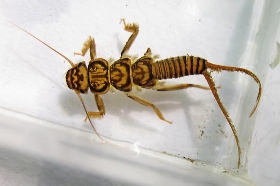
|
Caddisflies are insects belonging to the taxonomic order tricoptera.
They are known for their fascinating use of silk and stream substrate
to form protective cases around themselves during their aquatic, larval
phase. The tube-like cases can be made of sand and pebbles, pieces of
leaves, or small twigs. Caddisflies, like stoneflies, are intolerant of
water pollution, but are found in a wider variety of habitat types,
including ponds and warm waters. They also display a wider range of
feeding behaviors including predation, filtering, leaf-shredding, and
gathering of food particles, which makes caddisflies an especially
important player in the nutrient cycle of streams. The larva's head and
first thorax segment have hardened shells, and the caddisfly will use
its front appendages to walk around with its case attached. This larval
stage of feeding generally lasts one year, after which a pupal stage of
inactivity occurs. The emergence of adults is often triggered by the drop
in water temperature each autumn that helps to synchronize the hatch of
swarms of caddisflies ready to mate. Adult wings have a hairy appearance
and are held over the back like a roof or tent, making the caddisflies
resemble smaller moths.
Dragonflies are insects in the order odonata. People are most familiar
with the adult form that includes large compound eyes, colorful bodies,
and two sets of wings that are held outward from body. Unlike stoneflies
and caddisflies, dragonflies are strictly predators as larva and continue
to feed as adults. Possessing speed up to 34 mph, nearly 360' vision,
wing design that permits aerial acrobatics (hovering and reverse flight),
and legs that can grab on the go, dragonflies are proficient hunters that
provide valuable control of mosquitoes and other pests. These amazing
adults live less than six months—long enough to mate and lay eggs. Most
of a dragonfly's life is spent as an aquatic naiad. For up to five years,
these naiads will inhabit quiet waters and prey on other aquatic insects,
small fish, and tadpoles.
top
|
|
FAMILY FOCUS
|
Exploring Eelgrass
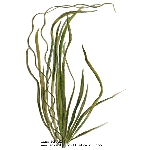 Environmental advocates often cite the adage, "We all
live downstream". This means that we all have a role in protecting the natural
resources where we live because our actions affect surrounding environments.
This is especially true in aquatic systems like the Blackstone River watershed.
What happens in the Massachusetts portion of the watershed affects the quality
of the Blackstone River in Rhode Island and the Narragansett Bay estuary into
which it feeds.
Environmental advocates often cite the adage, "We all
live downstream". This means that we all have a role in protecting the natural
resources where we live because our actions affect surrounding environments.
This is especially true in aquatic systems like the Blackstone River watershed.
What happens in the Massachusetts portion of the watershed affects the quality
of the Blackstone River in Rhode Island and the Narragansett Bay estuary into
which it feeds.
A primary component of the Narragansett Bay estuary is its eelgrass beds.
According to the conservation organization Save the Bay, "Eelgrass beds are a
primary source of food and shelter to an abundance of marine life, including
economically important finfish and shellfish, such as the Bay scallop."
(www.savebay.org).
Because of this, eelgrass beds are an indicator of the overall estuary's well
being. Unfortunately, most of the eelgrass beds have disappeared in Narragansett
Bay. This loss is due, in part, to degraded water quality, and that includes
excess nitrogen that is discharged into the Blackstone and its tributaries in
Massachusetts.
Watch the videos below to learn more about eelgrass, the animals that depend
on it, and how it's being restored. As a family, you can visit the estuary
and learn how to reduce nitrogen inputs. You can also find a stream or pond
closer to where you live and map out how water leaving your yard or driveway
reaches it. Are you doing your part to "live upstream" in a responsible manner?
top
|
|
BE GREEN
|
 Back To School
Back To School
Each autumn, the school bell rings again for children from
kindergarten through college. Time to pack lunches, snacks, and
backpacks. And time to teach an important lesson in the wise use of our
resources. Are they using both sides of their notebook paper? Can you
help organize walking or biking groups to cut down on car and bus fuel
consumption? Are they reusing lunch bags and food containers? Are your
kids' schools practicing recycling in the classroom? If not, have your
child talk with friends about organizing a program. How is the school
cafeteria doing reducing food waste? Reach out and see if they could
use help brainstorming. Consider visiting a thrift shop when stocking
up wardrobes. Many items like sweaters, slacks, rain boots, and jackets
can be found in great condition at a fraction of the cost compared with
retail shops.
Some material from
www.earthshare.org.
top
|
|
REFLECTIONS
|
“It is not half so important to know as to feel.” Rachel Carson
Acrostic poems are formed by having the first letter of each line spell
out a word that runs vertically.
Beautiful to experience on foot or by water
Lapping shoreline from Worcester to Pawtucket, water journeys for 48 miles
Attracts competitors and spectators alike for the annual Greenway Challenge
Canal once facilitated trade during America's mighty industrial revolution
Kingfishers dart from branches while anglers cast from shore, seeking the same prize
Shelters wide diversity of native plants and animals, all needing our protection
Tumbles 450 feet from headwaters to bay, creating power to be harnessed... but now released?
Over and over, the water cycle flows, allowing the Blackstone to do so as well
Nutrients, when discharged in excess, disrupt the balance of the riverine system
Explore, educate, energize, and envision our connected future: visit soon and often!
top
|
Views & opinions expressed in linked websites do not necessarily
state or reflect those of the BRWA.
|
|
Your input is crucial to this eNewsletter. If you have a local
watershed-related story, information of interest to our subscribers, or
comments about this publication, drop an email to the editor.
The Blackstone River Watershed Association (BRWA) has a mission to
engage, educate and advocate for improved water quality in the Blackstone
River Watershed; its objectives are to:
- Engage the public in watershed stewardship activities,
- Educate members, supporters and watershed residents on watershed protection strategies, and
- Improve the water quality and esthetics of the Blackstone River Watershed’s water bodies.
The BRWA eNewsletter is published monthly by the Blackstone River Watershed
Association. BRWA is a 501(c)(3) non-profit organization.
Editor: Susan Thomas susan.thomas@thebrwa.org
Mailing address: BRWA, 271 Oak Street Uxbridge, MA 01569
Phone: 508-278-5200 Web: www.thebrwa.org
Click here for back issues.
|
|



